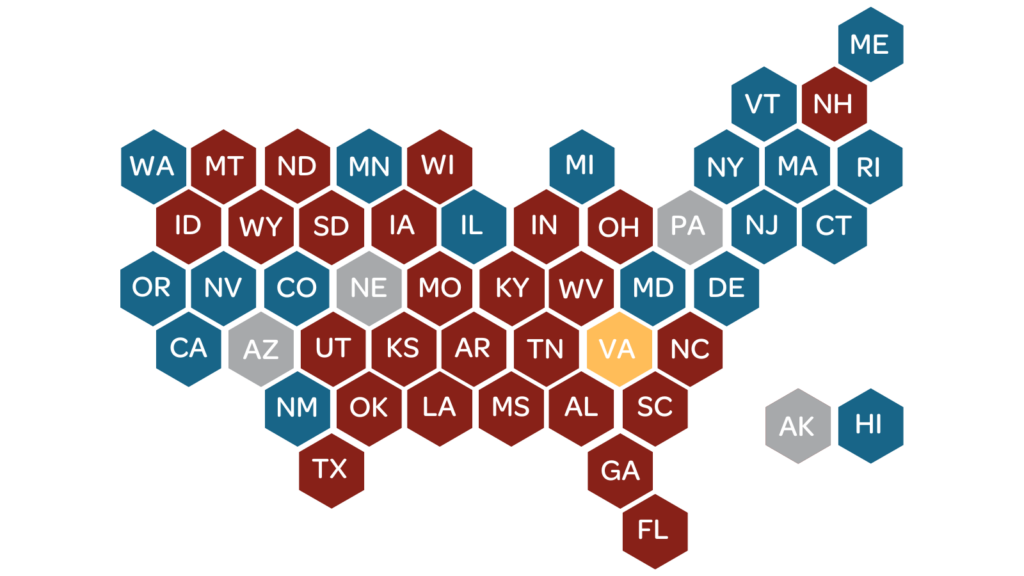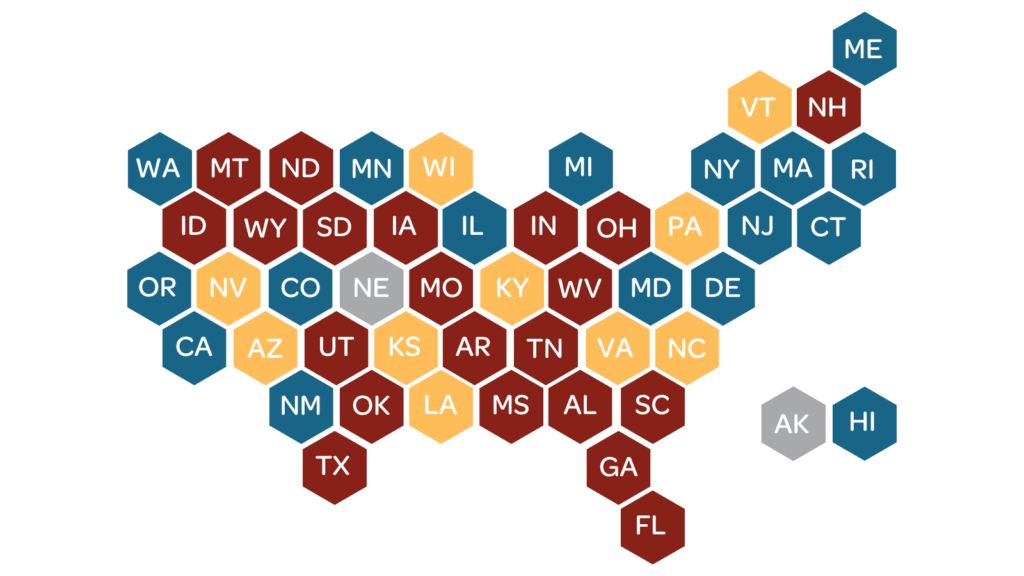
NCEL Blog
The 2022 Midterms: Impacts on States and Environmental Policy
November 16, 2022
Overview
Following the 2022 midterms, many states are now positioned to make or continue substantial progress on environmental legislation. This memo outlines what the state legislative landscape looks like following the elections and what the elections could mean for state environmental policy.
This year, 88 of the 99 legislative chambers across 46 states were up for reelection. There were four states that did not hold state elections – Louisiana, Mississippi, New Jersey, and Virginia. In addition, the Kansas, New Mexico, and South Carolina Senates were not up for reelection. Nebraska is a unicameral, nonpartisan legislature.
Prior to the midterms, Republicans controlled 61 legislative chambers and Democrats controlled 37 chambers. Minnesota and Virginia were the only states with split legislatures.
Broad Trends Across the States
Following the 2022 election, Republicans will hold 55 state legislative chambers and Democrats will control 39 chambers across the nation’s 98 partisan state legislative chambers. Compared to the 2020 elections, Democrats slightly expanded their legislative majority from 37 chambers.

Party control of Governorships flipped in Maryland and Massachusetts to Democrats and Nevada flipped to Republicans. The Gubernatorial wins in Maryland and Massachusetts created two new Democrat trifectas. Nevada’s Gubernatorial win breaks the Democrat trifecta that existed prior to the election. Democrat gains in Minnesota and Michigan also created two new Democrat trifectas.
Overall party control of the states — holding the House, Senate, and Governorship — is as follows:
- Republicans fully control 21 states. This is two fewer states than before the election.
- Democrats fully control 17 states. This is two more states than before the election.
- Nine states have divided governments with split control between legislatures and the governorship.
- Democrats established four new trifectas – Maryland, Massachusetts, Minnesota, and Michigan.

Role of States After the 2022 Election
With Republicans gaining a slim majority in the House of Representatives, actions at the federal level will be slowed or halted due to gridlock. The new split in Congress will make it harder for monumental federal legislation to pass.
States always play a crucial role in environmental policy, whether it’s pushing the federal government to act, implementing the policies of the federal government, or stepping up when the federal government lacks action. Following the 2022 elections, state action will once again be relied upon to keep climate and environmental action moving forward.
Following the 2022 elections, states are poised to make huge progress on environmental legislation in the upcoming sessions. Whether fueled by the historic investments from federal legislation or from the four new trifectas established, NCEL feels confident that the 2023 session will be a landmark one for state environmental policy.
States are already working on their own bold environmental legislation but now with federal funds from the BIL and IRA, states have the ability to steer us in a direction where the US can potentially meet the needed emission reductions by 2030. States will also continue working to meet 30×30 conservation goals in alignment with the America the Beautiful plan as well as continue to expand offshore wind following the Administration’s goal of deploying 30GW of offshore wind by 2030.
Impacts on State Environmental Policy
Following the 2022 elections, many states are poised to move state environmental action forward in the upcoming legislative sessions. NCEL staff have outlined the impacts of the election on key policy areas and what to expect for 2023.
Climate and Energy | Conservation | Environmental Health | Oceans
Federal Funding – The Inflation Reduction Act (IRA) of 2022 invests a historic $369 billion in climate and energy investments, many of which will be applied by states. If implemented properly, state legislators can build on their 2022 environmental policy accomplishments and get the US close to meeting our emission reduction goals by 2030. The outcome of elections in states will impact how that money is applied and spent. Many states will focus on creating green banks and taking advantage of the various conservation and climate programs created by both the IRA and the Bipartisan Infrastructure Law (BIL). NCEL will continue to provide support to legislators whose states stand to benefit from these bills through our various IRA and BIL resources.
Environmental Justice – There has been a continued emphasis on environmental justice in recent years With the passing of bills such as Maryland’s Environmental Justice Screening (HB1200) and Vermont’s environmental justice policy (S. 148) in 2022, other states are starting to look for ways to incorporate environmental justice into their work, rules, and procedures. There has also been an overall increase in broadening the stakeholder engagement process as seen through the various climate justice policies from 2022. NCEL staff expect to see greater state policy focus on environmental justice and equity in 2023.

Climate and Energy
Transmission and Grid Policy – The past two years have seen a large increase in legislative action and attention around grid and utility policy. Legislators have organized in various regions pushing for better renewable policies in the Mid-Atlantic (PJM) and Northeast (ISO-NE). As the clean energy transition continues to accelerate, especially with a federal administration focused on climate and the new federal funds, modernizing and improving transmission will be paramount. NCEL staff expect to continue working with legislators throughout 2023 on ways to modernize the grid and ensure utility policy is receptive to renewables.
Electric Vehicles – With federal grant programs and a continued federal focus on increasing the use of electric vehicles, states will continue working to ensure EV adoption in their states, as well as the best method for building out charging infrastructure. Many states were already working on this in 2022, now with the influx of federal funds and the political makeup, NCEL staff believe there are many states that will see movement this year.
Green Buildings – Many states that are leading on climate action view building emissions as the next source to address. Supported by IRA funding and tax credits, states are looking at building performance standards, addressing natural gas in new construction, and incentives for heat pumps and electric appliances. Going into 2023, watch for states to build on existing action and for states with new majorities to introduce legislation to tackle building emissions.

Conservation
Land and Water Conservation – With President Biden’s focus on 30×30 through the America the Beautiful plan, NCEL staff expect to see continued state action on this front. States are continuing to work towards establishing their own 30×30 goals as well as supporting the federal efforts to get there. Many states are using the concept of habitat connectivity to both achieve 30×30 goals as well as protect biodiversity.
Biodiversity Protection – The United States is one of the only countries in the world without a national biodiversity strategy. In 2022, legislators urged the Biden Administration to create one. Throughout 2022, in addition to urging federal action, many states also considered their own bills to protect biodiversity. With the likely continued lack of a national strategy, states will continue working to strengthen state endangered species acts, ensure better management of invasive species, protect against future zoonotic disease outbreaks, and through habitat connectivity.
Strengthening State Wildlife Agencies – State wildlife agencies are in charge of managing the wildlife within state boundaries, but are facing severe budget crises. Revising the funding structure of wildlife agencies and strengthening the protections under state endangered species acts will give these agencies the funding and authority needed to address the increasing biodiversity crisis. States are urging support from the federal government to provide funding to help increase agency capacity.

Environmental Health
Plastic Pollution – The past few years have seen a surge in public interest and legislative action across the plastic lifecycle. In 2022, 36 states introduced over 280 bills related to plastic pollution. Extended Producer Responsibility (EPR) bills for paper and plastic packaging are gaining traction in multiple states with two states, California and Colorado, passing EPR legislation in 2022. Single-use plastic reduction options, including EPR and bottle bills, and banning chemical recycling practices were also avenues states considered in 2022. NCEL staff expect to see continued focus on this topic in 2023 and the potential for multiple state policy successes as lawmakers and advocates center their efforts on the entire plastic lifecycle and its detrimental effects on health.
Toxic Chemicals – States continue to pursue limits and regulations on PFAS chemicals to address their threat to drinking water, food, firefighters, and farmland. In 2022, four new states passed bills increasing the regulation of PFAS in food packaging and 31 total states considered PFAS legislation. NCEL expects to see continued progress toward solutions that protect communities and move toward safer and more sustainable materials heading into 2023.
Sustainable Agriculture and Water – In the coming year, states will continue to work on sustainable agriculture, soil health, and water quality and quantity issues. Especially with the historic Infrastructure Investment and Jobs Act (IIJA) investment in water, other federal funding opportunities, and the 2023 Farm Bill Reauthorization, states will play a crucial role in supporting and implementing federal initiatives. Recent historic droughts and floods across the nation will also highlight the importance of these policy initiatives.

Oceans
Offshore Wind – In 2022 alone, state legislators introduced nearly 30 bills across 10 states related to offshore wind. The passage of the IRA bolstered offshore wind development – the legislation allocates $100 million for interregional and offshore wind electricity transmission planning, modeling, and analysis while also extending the existing energy investment tax credit. NCEL staff anticipate state legislators will capitalize on the IRA’s offshore wind funding by advancing more legislation in 2023.
Coastal Resilience and Restoration – Severe weather events are threatening the natural and built environment of coastal areas. The IRA allocates $2.6 billion to the National Oceanic and Atmospheric Administration (NOAA) for states to conserve, restore, and protect coastal and marine habitats, prepare for extreme storms, and support natural resource projects that sustain coastal and marine-dependent communities. In 2022, states like Virginia and North Carolina worked to make their coastlines more resilient by funding flood and storm-resilient infrastructure. 2023 will bring increased focus on coastal resilience and restoration as natural disasters continue.
Protecting Blue Carbon – Blue carbon ecosystems – ocean and coastal ecosystems that naturally capture carbon — can sequester and store more carbon per unit area than terrestrial forests. This year, state legislators in Washington passed S.B.5619, which supports the restoration of blue carbon ecosystems. For 2023, NCEL staff anticipate increased attention to protecting blue carbon ecosystems, especially as more states work towards setting and achieving their respective 30×30 goals.
Ballot Measures
States voted on a handful of energy and environmental ballot measures. Below is a brief recap of some of the major measures:
- California Proposition 30: FAILED
Imposes a new 1.75% personal income tax on individuals making over $2 million a year and dedicates revenue to funding electric vehicle rebates, zero-emission vehicle charging infrastructure, and wildfire response and prevention.
- Massachusetts “Fair Share Amendment”: PASSED
Imposes an additional tax of 4% on income over the million-dollar mark. The revenue would be used to fund investments in transportation and education.
- New York Clean Water, Clean Air, Green Jobs Bond Act: PASSED
Issues $4.20 billion in general obligation bonds to fund various priority environmental projects including flood risk reduction, open space land conservation and recreation, climate change mitigation, and water quality improvements.
- Rhode Island Environment and Recreation Bond Measure: PASSED
Issues $50 million in bonds for environmental and recreational purposes including brownfield remediation, forest and watershed restoration, and a local recreation development grant program.